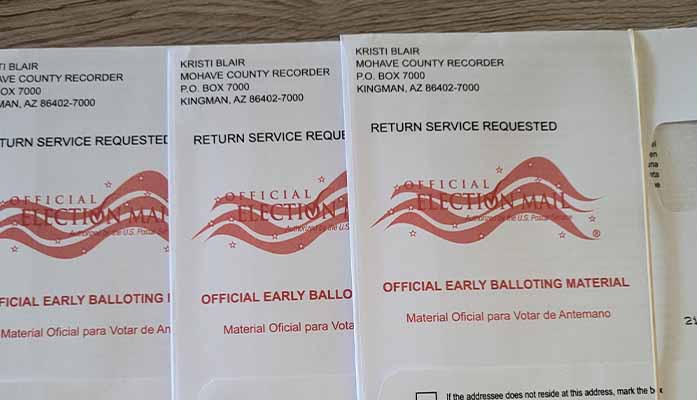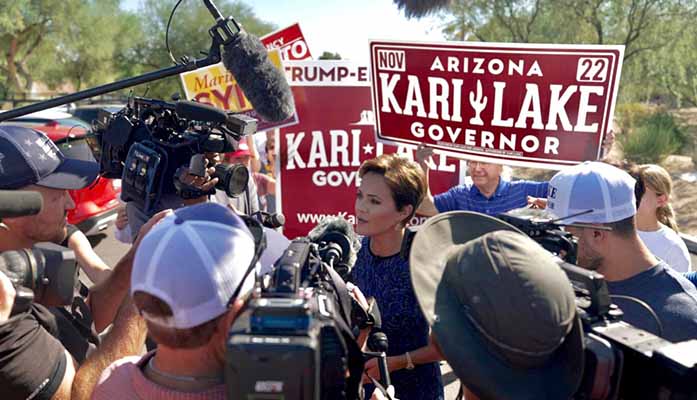
by Ethan Faverino | Aug 13, 2025 | Education, News
By Ethan Faverino |
A new report from the Common Sense Institute (CSI) revealed a crisis in Arizona’s district public school system, marked by declining enrollment, expanding infrastructure, and misallocated resources that fail to serve students effectively.
Despite a 5% drop in district school enrollment since 2019, Arizona’s public-school districts have continued to expand facilities, increase capital spending by 67% to $8.9 billion, and boost transportation costs by 11.3% to $561.2 million, even as eligible bus riders plummeted by 45%.
As Arizona’s population surged, districts expanded, constructing thousands of school buildings, hiring teachers, and extending bus routes to accommodate a growing student body.
Since peaking in 2008 with 931,000 students, district school enrollment has steadily declined, dropping to 859,519 students by 2024—a 5% decline since 2019 alone.
According to the report, this trend is accelerating, driven by demographic shifts and changing parental preferences.
Arizona’s school-aged population (ages 5–17) shrank for the first time in 2022, with a loss of 30,000 children by 2023.
Meanwhile, school choice has reshaped the educational landscape with 40% of incoming kindergarteners now opting for charter or private schools, which operate with leaner facilities and no formal transportation systems.
In the meantime, Arizona’s district schools have doubled down on expansion. Since 2019, districts added 499 new buildings, increasing gross square footage by 3% to 148.6 million square feet—78 million square feet more than needed, enough to accommodate 630,000 additional students.
The fastest-shrinking districts have increased capital spending the most, with 20% of districts (serving 73% of students) receiving 81% of capital funding.
Math proficiency in Arizona’s district schools fell 25% since 2019, and English proficiency dropped 5%, according to NAEP assessments.
Staffing has grown by 1.5% to 108,330 employees, with teacher salaries rising 24.1% to $65,113, yet class sizes remain stable at 17.7 students per teacher.
Administrative staffing has surged 6.7% since 2019, outpacing classroom staff growth, but these investments have not translated into academic gains.
Ethan Faverino is a reporter for AZ Free News. You can send him news tips using this link.

by Matthew Holloway | Aug 13, 2025 | News
By Matthew Holloway |
The Uniformed and Overseas Citizens Absentee Voting Act (UOCAVA) has become the center of controversies in Arizona in the past few days, involving Arizona’s Democrat Secretary of State Adrian Fontes and a raft of reforms to the act proposed by Congressman Abraham Hamadeh (R-AZ08).
According to a press release from State Representative John Gillette’s office (R-LD30), “Fontes ordered counties to abandon the secure, state-managed Uniformed and Overseas Citizens Absentee Voting Act (UOCAVA) ballot processing system and instead use a third-party platform controlled solely by his office.”
Gillette condemned Fontes, saying, “UOCAVA exists to ensure that our deployed service members, their families, and Arizona residents living overseas can securely exercise their right to vote. He explained, “It does not give voting rights to foreign nationals, illegal immigrants, or U.S. citizens with no prior Arizona residency. This directive is a reckless expansion of voting access beyond what the law allows.”
The release from Gillette’s office added, “The change undermines the clear intent of federal law, circumvents the Arizona Election Procedures Manual—which requires a public process and legislative oversight before such changes—and risks improper use of federal funds designated for legitimate UOCAVA services. Removing counties from control also weakens ballot verification and tracking safeguards that protect against fraud.”
In a statement released by the Secretary of State’s office, Fontes characterized his change as “the upgrade we’ve been working toward for 20 years.”
On the federal stage, the Proving Residency for Overseas Voter Eligibility (PROVE) Act, introduced by Rep. Hamadeh earlier this month, drew the ire of elections reporter Garrett Archer of ABC 15. The self-proclaimed “data guru” held the reforms to be unnecessary, according to the Arizona Daily Independent. Archer has been in an ongoing social media feud with Hamadeh and his staff regarding UOCAVA voting totals.
Introducing the measure, Hamadeh warned that the UOCAVA allows people who have never resided in the U.S. to vote in state elections, undermining the integrity of the electoral process. “The loophole in UOCAVA allows citizens living overseas, with no current ties to a state, to arbitrarily choose where their vote counts,” he said. “This threatens electoral integrity and is an affront to everyone who believes in fair and free elections. The PROVE Act will close this loophole and go far to restore trust in our elections.”
Hamadeh explained in a post to X:
“The military and overseas citizen voting data reveals some concerning patterns: Volume Stats:
• Total UOCAVA ballots transmitted: 1,327,324
• Here’s the kicker: 70% went to overseas citizens, not military voters
• That’s the largest gap between overseas civilians and uniformed services since 2014.”
Archer accused the congressman of “still lying. Just with numbers this time.” He argued, “The four states with a concentration of UOCAVA voters are Virginia, Florida, Washington, and California. The UOCAVA voters in the first three are all majority military. Virginia is near the seat of government, Washington and California both have aerospace and tech industries. Abe is implying its suspicious that a random county in Oklahoma or Nebraska DO NOT have over 100 UOCAVA voters. Quite the opposite in fact. If a random county in Oklahoma or Nebraska had over 100 UOCAVA voters, that would be suspicious.”
In response to another post from Archer, who shared his breakdown of UOCAVA registrations in 2024 by Arizona counties, Hamadeh asked, “Why aren’t you using the military numbers? Is it because it completely invalidates your rebuttal? This bill ensures that military voters are protected and loopholes are closed.”
Hamadeh then cited Hans von Spakovsky, Election Law Reform Initiative and Senior Legal Fellow at the Edwin Meese III Center for Legal and Judicial Studies: “‘The typical civilian Congress was looking at [when UOCAVA was created] was, for example, a State Department foreign service officer in Europe for a several-year assignment who would return to his or her home in Maryland or Virginia or another state when that assignment ended,’ Spakovsky told The Federalist. Spakovsky explained the legislation was surely not intended to permit expatriates, or other individuals who left the country and have no intention of ever returning, to continue voting.”
Answering the efforts of Adrian Fontes to interfere, and blasting the Democrat in a post to X, Hamadeh wrote, “Overstepping his authority & again demonstrating his flagrant disregard for the integrity of our elections, @Adrian_Fontes is exploiting voting in the name of the very servicemembers who protect that freedom. Congressman Hamadeh’s PROVE Act fixes this.”
Matthew Holloway is a senior reporter for AZ Free News. Follow him on X for his latest stories, or email tips to Matthew@azfreenews.com.

by Matthew Holloway | Aug 12, 2025 | News
By Matthew Holloway |
Legal documentation obtained by AZ Free News has revealed detailed allegations surrounding the pending termination of Voice of America (VOA) Director Michael Abramowitz and the assertions of U.S. Agency for Global Media (USAGM) Acting-CEO Kari Lake that efforts to block his termination are unconstitutional.
As previously reported by AZ Free News, Abramowitz received a notice of reassignment to become the Chief Management Officer of the VOA’s Edward R. Murrow Transmitting Station of the International Broadcasting Bureau in Greenville, NC. It was conveyed to him in a July 8th memo that “this geographic reassignment was needed to ensure adequate front-office supervision of USAGM’s primary domestic transmission facility for VOA content during this key transitional period.”
Per the response to Abramowitz’s legal motion, USAGM leaders informed Abramowitz at that time that his “presence in Greenville was needed to support an evaluation of the potential for an expanded USAGM staff presence at that facility.”
In a notification sent to Abramowitz, Senior Advisor to USAGM John Zadrozny wrote:
“The memorandum further directed you to complete and return the acknowledgment section to the Office of Human Resources at ExecutiveResources@usagm.gov no later than July 29, 2025.
“It also stated in no uncertain terms that, should you decline to accept the reassignment, you would be subject to removal under adverse action procedures pursuant to 5 U.S.C. § 7543. On July 29, 2025, you declined the reassignment.”
In a post to X on Monday, Lake explained, “The Former VOA Director was offered the opportunity to continue his employment at our transmitting station in North Carolina, a place that could benefit from his experience. Unfortunately, he declined his reassignment.”
The document further describes the justification for Abramowitz’s removal, stating, “The reassignment to Greenville was strategically aligned with agency priorities. Specifically, your presence at the Edward R. Murrow Transmitting Station was needed to ensure executive-level oversight and leadership during a critical period. This new role would have included directing and focusing staff at the facility on clearly defined operational and strategic priorities, while continuing to maintain and improve day-to-day operations there. It also involved providing regular feedback, direction, and training to ensure the facility staff remained engaged in fulfilling key agency objectives, including efforts to streamline agency functions in accordance with statutory requirements.”
Addressing Abramowitz’s argument that “Congress expressly provided that the ‘head[] of Voice of America . . . may only be . . . removed if such action has been approved by a majority vote of the [International Broadcasting] Advisory Board,’” the USAGM leadership counters that “the Chief Executive Officer, acting on the President’s behalf, may lawfully remove the Voice of America Director, an inferior officer.”
In the filing, USAGM argues, “The power to remove an inferior officer can be vested only in ‘the President alone, in the Courts of Law, or in the Heads of Departments,’” citing the U.S. Constitution as well as other legal precedents. “Here, that means the Voice of America Director—an inferior officer—must be removable at will by the President or the Agency’s Chief Executive Officer (the head of the Agency) acting on the President’s behalf.”
The agency also argues that, along constitutional grounds, due to the USAGM’s status as an executive branch agency, the U.S. District Court “lacks the power to enjoin Mr. Abramowitz’s removal as the Voice of America Director.” It notes that “under traditional principles of equity, courts of equity have no power over appointments and removals.”
In a brief statement to AZ Free News, Lake wrote, “We have numerous SES (Senior Executive Service) employees, all of whom are paid handsomely, and some of whom have been sitting home on paid administrative leave collecting a paycheck, but not working. That’s not fair to the taxpayer. We have positions where we need their skills, and we are attempting to get them into place where they can be helpful to our mission.”
Matthew Holloway is a senior reporter for AZ Free News. Follow him on X for his latest stories, or email tips to Matthew@azfreenews.com.

by Jonathan Eberle | Aug 12, 2025 | Economy, News
By Jonathan Eberle |
Lucid Group, the electric vehicle startup known for its luxury Air sedan, disappointed investors after missing second-quarter earnings expectations and trimming its production forecast for 2025.
The company reported $259.4 million in revenue for the quarter ending June 30, falling short of Bloomberg’s $262.4 million consensus estimate. While that figure marked an improvement over the $200.6 million recorded a year ago, Lucid posted a larger-than-expected adjusted loss of $0.24 per share and an adjusted EBITDA loss of $632.1 million.
Gross margins fell by 21%, which Lucid attributed to tariffs. The company ended the quarter with $4.86 billion in liquidity, a closely watched metric as it continues to burn cash. Production guidance for 2025 was revised to between 18,000 and 20,000 vehicles, down from the 20,000-target set earlier this year. In the April–June period, Lucid produced 3,863 vehicles and delivered 3,309, bringing its first-half totals to 6,075 units produced and 6,418 delivered.
For much of its short history, Lucid’s lineup consisted solely of the Air sedan. The automaker has recently begun ramping up production of the Gravity SUV, though early output has been modest. Fewer than 1,000 units were built in the first quarter, most of which went to Saudi Arabia, home to Lucid’s largest investor, the Saudi Public Investment Fund.
In 2016, the Arizona State government made a deal with Lucid to open operations in Arizona. At that time, the Arizona Republic reported that the company could receive as much as $46.5 million in taxpayer subsidies over time. The company’s primary manufacturing facility remains in Casa Grande, Arizona.
In July, Lucid announced a partnership with Uber to supply 20,000 battery-electric vehicles for a planned robotaxi service over the next five years.
Lucid’s near-term sales outlook also faces headwinds from the expected expiration of the U.S. federal $7,500 EV tax credit on Sept. 30. To bolster its stock price, the company plans a 1-for-10 reverse stock split, which would lift shares to roughly $10 based on current valuations and help avoid the risk of trading below $1. Shares of Lucid (LCID) fell nearly 2% following the earnings announcement.
Jonathan Eberle is a reporter for AZ Free News. You can send him news tips using this link.

by AZ Free Enterprise Club | Aug 11, 2025 | Opinion
By the Arizona Free Enterprise Club |
Seven months into Trump’s return to office, the wreckage of the Biden administration continues to surface—especially in America’s transportation infrastructure. Previously, we highlighted the troubling impact of Pete Buttigieg’s tenure as Secretary of Transportation. His legacy of failure is becoming increasingly clear and public as new coverage reveals how his ideological grant programs, neglect of core responsibilities, and blatant mismanagement have damaged our economy, harmed communities, and sabotaged our personal freedoms.
As covered by the New York Post, Buttigieg, who was charged for four years to oversee the world’s most significant infrastructure network, instead made it his mission to “reimagine” the entire system, framing it as irredeemably racist and in need of dismantling as he famously told Al Sharpton in his “roads are racist” interview. Buttigieg funded his radical agenda through a series of state and local grants. Programs like “Reconnecting Communities” funded the removal of functional highways based on the claim they were originally designed to displace minority neighborhoods, even though those highways are used today by people of all races.
These weren’t transportation programs—they were anti-transportation programs. They prioritized “road diets,” bike lanes, and leveling roads in the name of equity while Americans sat in traffic and airports collapsed under system failures.
The AZ Free Enterprise Club was one of the only organizations sounding the alarm about the ideological hijacking of the USDOT which even despite mainstream knowledge of the corrosive teachings of critical race theory in k-12 education brought to light after COVID, seemed far-fetched to many. We documented how seemingly harmless programs like Vision Zero and the Safe Systems Approach—heavily funded through federal transportation grants—were actually vehicles for social engineering.
Now it is clear how thoroughly he indoctrinated the administration…
>>> CONTINUE READING >>>





